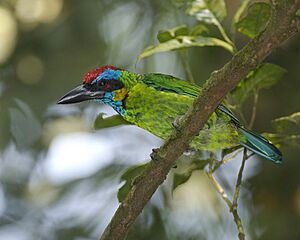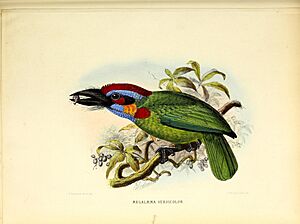Red-crowned barbet facts for kids
Quick facts for kids Red-crowned barbet |
|
|---|---|
 |
|
| Conservation status | |
| Scientific classification | |
| Genus: |
Psilopogon
|
| Species: |
rafflesii
|
| Synonyms | |
|
Megalaima rafflesii |
|
The red-crowned barbet (Psilopogon rafflesii) is a colorful bird found in Southeast Asia. It belongs to the same bird group as woodpeckers. You can find it in countries like Myanmar, Thailand, Malaysia, Singapore, Indonesia, and Brunei. These birds love living in warm, wet lowland forests and even in tree plantations. Their home covers a huge area, about 3,180,000 square kilometers.
Contents
What Does a Red-Crowned Barbet Look Like?
The red-crowned barbet is a medium-sized tropical bird. It is about 24.5 to 27 centimeters (around 10 inches) long. It weighs between 99 and 150 grams (about 3.5 to 5.3 ounces). Both male and female barbets are mostly green. They have a bright red crown on their head. They also have red spots below their eyes and a red mark on the side of their neck.
Their throat is blue, and they have wide blue stripes above their eyes. Their face is a mix of black and yellow. Young barbets and females look similar to males, but their colors are a bit duller.
Where Red-Crowned Barbets Live
The red-crowned barbet lives in the lowlands and hills of Southeast Asia. This includes southern Myanmar, peninsular Thailand, and parts of Malaysia like Sabah and Sarawak. They are also found in Singapore, Kalimantan, Sumatra in Indonesia, and Brunei.
These birds spend their days flying around the lower parts of the forest canopy. They live in both new and old-growth forests. Farmers have even seen them flying through rubber and durian fruit farms looking for food. Sadly, because of deforestation in Singapore, the red-crowned barbet now mostly lives in the Bukit Timah Nature Reserve.
How Red-Crowned Barbets Behave
What Red-Crowned Barbets Eat
The red-crowned barbet mostly eats fruits from the lower parts of trees and vines. They especially love figs from the Malayan banyan tree. Their long, thick beak helps them open these figs easily. They also eat many other fruits like oil fruits, palm fruits, and wild cinnamon.
When they eat fruits, they help spread seeds for the trees. Sometimes, they might even protect their favorite fruit trees from other barbets. This helps different barbet species find their own food sources. Besides fruit, red-crowned barbets also eat land snails.
Their beak is also great for finding insects. They dig into rotten wood to find grubs, termites, mantises, moths, katydids, and ants. They sometimes follow other insect-eating birds to find hidden food in dead wood. In Singapore, the green coffee tree is now endangered partly because red-crowned barbets forage on it.
Red-Crowned Barbet Reproduction and Life Cycle
The breeding season for red-crowned barbets is usually in April and May. It lasts for about 36 days. Before they start looking for a mate, the birds make loud calls in the morning and evening. Females make a "kotroo kotroo" sound, and males call "kurro kuroo."
Once a female finds a male, their courtship begins. The male will sit next to the female and gently preen her feathers. If she likes him, he will fly off to find insects and fruits. He brings the food back and feeds it to her. After about 10 to 20 minutes, the female will make soft churning calls. She will swing her tail, fluff her feathers, and slightly lower her wings. This shows she is ready to mate.
The pair chooses a dead tree to peck a hole for their nest. This hole is usually about 20 to 30 feet (6 to 9 meters) above the ground. Scientists think they face the hole south to protect the nest from monsoon rains. As they peck, they use their beaks to toss wood bits and dust to the ground.
Their nest is about 30 centimeters (12 inches) deep. It has a smooth chamber at the bottom for the eggs. To get into the nest, they go through a tunnel about 4.5 centimeters (1.8 inches) wide. This tunnel then drops slightly into the chamber, which widens to about 16 centimeters (6.3 inches). The smooth walls mean they don't need to add any nesting material.
The female usually lays three glossy white, oval-shaped eggs. Each egg is about 26.20 x 20.30 millimeters. Both parents take turns sitting on the eggs for 14 to 15 days. They switch roles every 20 to 30 minutes. Once the eggs hatch, the parents start collecting food for their chicks. They feed the chicks directly and remove any waste to keep the nest clean. When the young birds are older, the parents feed them from the entrance of the nest.
Status of the Red-Crowned Barbet
The red-crowned barbet is currently listed as Near Threatened on the IUCN Red List. This means it could become endangered in the future if its habitat continues to shrink.



